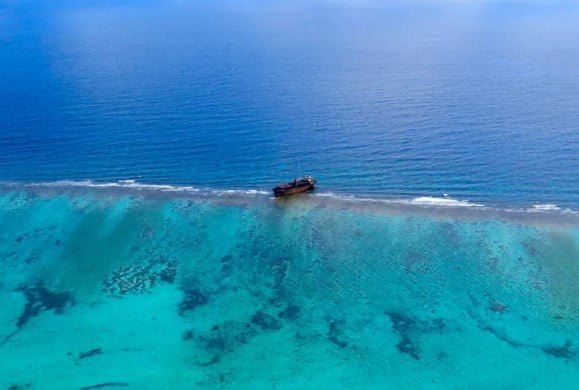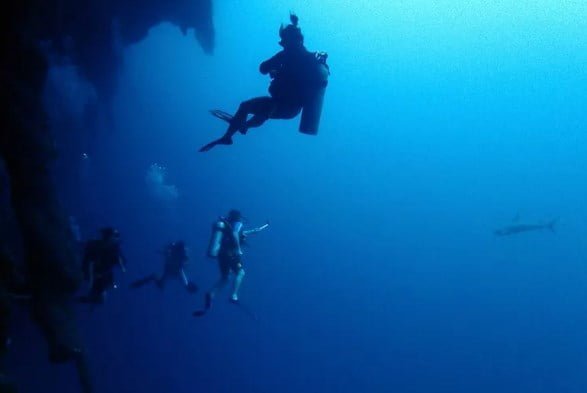Surrounded by the Lighthouse Reef atoll, the Great Blue Hole is a natural sinkhole that measures roughly 1,000 feet across and 400 feet deep. Seen from space, the center of the hole is a deep navy blue that stands out in a sea of aquamarine waters and white-sand beaches.
The Great Blue Hole is believed to be the world’s largest feature of its kind and is part of the Belize Barrier Reef Reserve System, a UNESCO World Heritage Site. The sinkhole formed during the last glacial period, sometime between 25,000 to 100,000 years ago (though some experts say it could be as old as 150,000 years), and it was later flooded by rising ocean levels. It is one of the most popular dive sites in the world, made famous by Jacques Cousteau who visited in the 1970s and named it one of the best diving spots on the planet.

Here’s what you need to know to plan the perfect trip to Belize’s Great Blue Hole.
The Great Blue Hole is about 43 miles from mainland Belize, but most visitors will be visiting via boat or helicopter from one of Belize’s many barrier islands.
Getting there by boat can take between three and four hours, depending on if you’re coming from the north or the south.
If you’re looking for a budget-friendly way to see the Great Blue Hole, you can arrange for a shared tour with a local tour operator like Amigos Del Mar, which Johnson recommends. If you want something a little bit more intimate, you can jump to the next tier and charter a boat exclusively for your group or even book a multi-night catamaran adventure.

Diving the Great Blue Hole
The Great Blue Hole is one of the most famous dive sites in the world, drawing people from all over the planet who want to explore its mysterious depths. There are millennia worth of stalactites, stalagmites, and, yes, even a few sharks. The entire area surrounding the Great Blue Hole is prime real estate for spotting a kaleidoscope of tropical fish, shrimp, and other Caribbean wildlife, so it’s a paradise for people who love to explore the world below the surface of the water.
That said, only those who are fully qualified can dive here — it is not a dive for beginners. To be qualified, divers need at least an Open Water or Advanced Open Water diving certification. Before diving the Blue Hole, divers will typically practice their skills with a divemaster who will make the final call on whose skills are up to the challenges of the Blue Hole. (Ask your tour operator for the specific requirements before you book.)
San Pedro in Ambergris Caye has many dive shops to choose from, such as Belize Pro Dive Center, Ambergris Divers, Belize Diving Adventures, and Amigos Del Mar. You can also depart from Caye Caulker, which has several dive shops, like Scuba Sensation and Frenchie’s Diving. The price is roughly the same (typically starting around $300 before equipment rentals), no matter which island you’re leaving from.
If you are doing a day trip, the itinerary will likely include a couple of additional dives along the Belize Barrier Reef. Multi-day liveaboard packages are ideal for divers who want to check out multiple dive sites in the area.
Truly, there is no bad time to dive in Belize, but the best months to dive the Great Blue Hole are April, May, and June, according to the PADI blog. This is when you’ll have peak visibility, fewer crowds, and the potential to see whale sharks. Visibility is also good from June through November, but because it’s the rainy season, the water can be bumpy. December through April is the dry season, so expect fantastic weather but know that this is peak tourist season so prices will increase along with the number of visitors.
